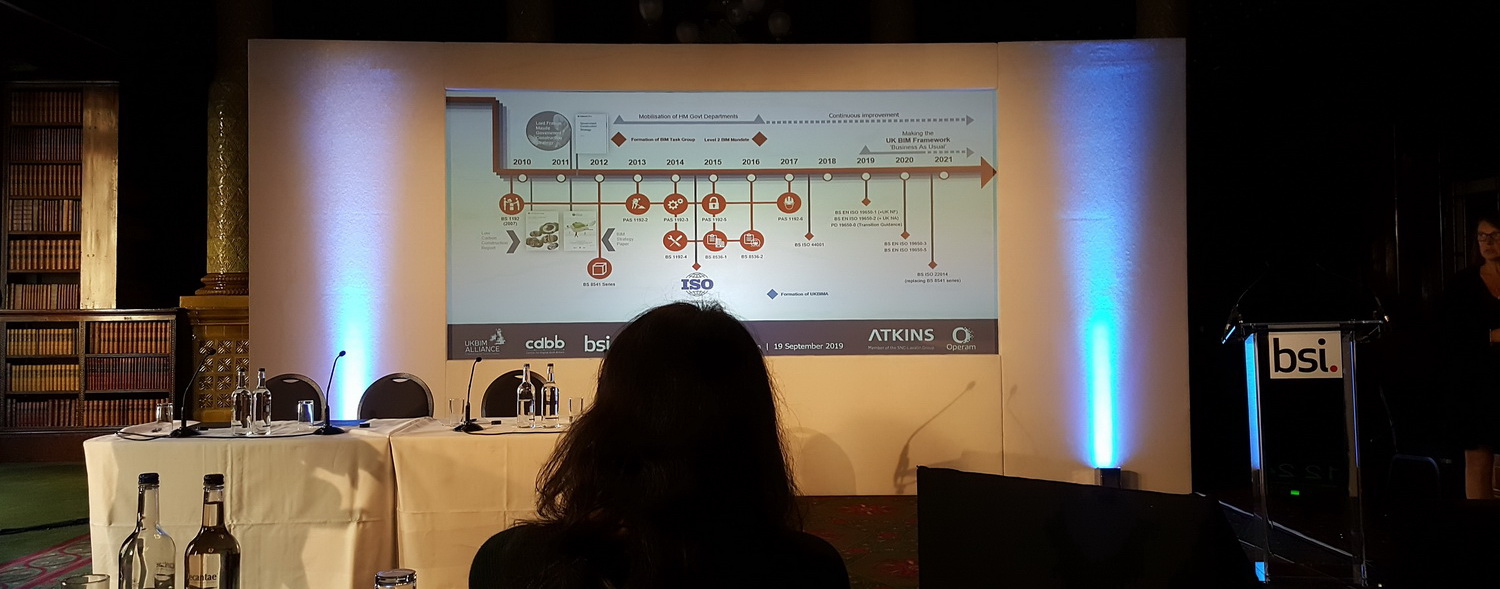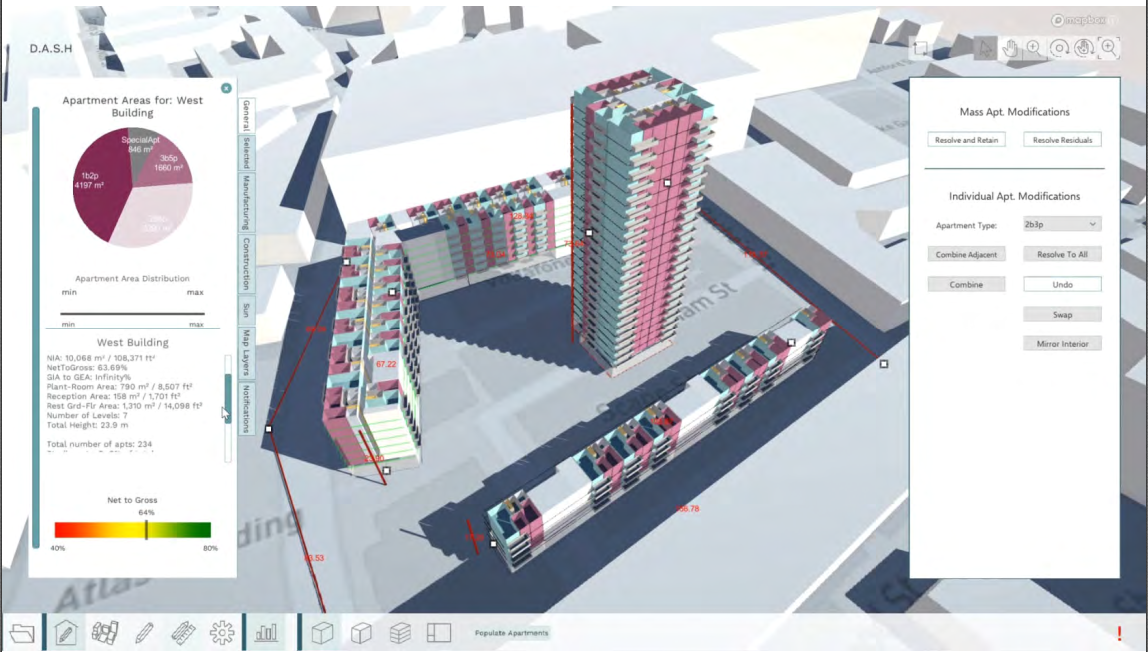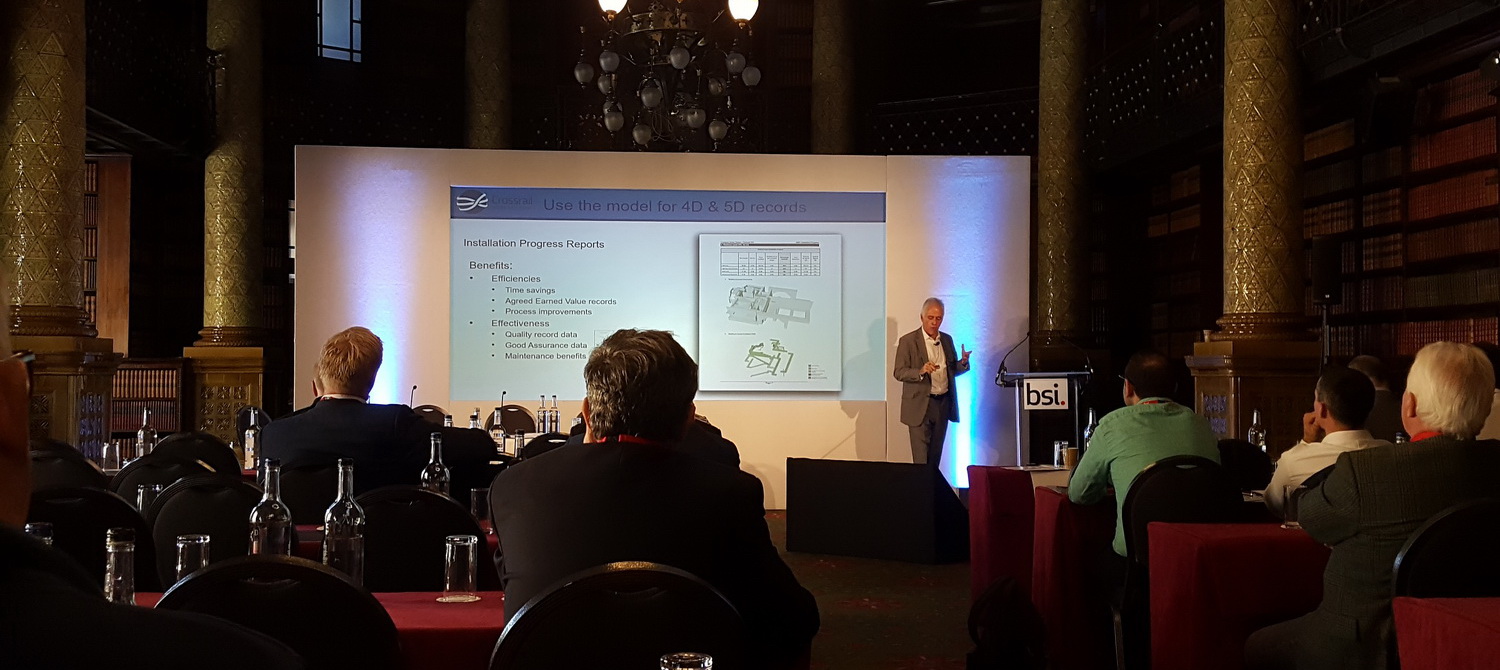The Digital World: BIM event was held in central London in late September 2019. Organized by BSI Group, the British Standards Institute, this one-day conference welcomed over 100 attendees and speakers from a broad variety of fields and constituencies who spoke on an array of BIM topics. Talks ranged from embedding data to blockchain to advanced use of BIM in the field.
The result was a diverse series of talks that in combination created a useful snapshot of the current status of BIM in the UK. BIM momentum in the UK received a major boost in 2011, when the British government announced an ambitious goal requiring “all [building] project and asset information, documentation and data to be electronic, to support efficient delivery at the design and construction phases of the project.” My first introduction to the UK’s BIM initiative was a presentation at the 2010 BIMForum in Phoenix, so this recent event was a welcome update on progress since then.
Overall, it’s clear the initiative has been a resounding success, at least in assessing the maturity of the BIM content I experienced. I can’t vouch for the state of BIM in the UK prior to 2011, but by late 2019 it certainly looks to be a mature endeavor with many of the presenters showing advanced use of BIM and advanced technologies in their talks.
MORNING PRESENTATIONS: BIM, BLOCKCHAIN, AND ISO
The conference began with a series of core technology discussions on BIM and emerging topics. After a brief introduction by the moderator Richard Waterhouse, I kicked off the morning talks with "BI(m), BIM data without Models" reprising my recent article on BIM and data, especially the power of what I call pure data, or structured asset data in simple text format. The core idea is that pure data offers the opportunity to link and unify several data sources in design, including GIS data and detached operations sources.
Next up was Martin Poljansek from the European Commission, who spoke about blockchain, and its value as a central ledger for project communications in a shared BIM world. Martin’s presentation was particularly revealing for me as I often think (I admit, erroneously) that Blockchain and Bitcoin are the same thing. But Martin’s presentation clearly explained the difference and that blockchain technology, especially “permissioned blockchain,” would have some useful applications in construction, as it is both protected and much more nimble due to its smaller scale. This was a useful eye opener for me.
Later in the morning, Anne Kemp, OBE and Paul Shillcock described their herculean effort of creating the new ISO 19650 standard, essentially creating an International BIM standard. This is a very worthwhile endeavor that builds on the BIM standards developed by the UK over the past few years. The UK series of PAS-1192 (Publicly Accessible Specifications) BIM guides produced since 2011 contributed to the basis of the new ISO International Standard, with regional variation. Parts 1& 2 of the ISO standard are already released with Parts 3, 4 and 5 scheduled for release in 2020.
 A Snapshot of the Development of the New ISO 19650 Standard
A Snapshot of the Development of the New ISO 19650 Standard
The morning sessions wrapped up with a highly visual presentation by Foster + Partners of recent projects where they have used generative design tools to generate and optimize design solutions using advanced scripting and BIM tools.
AFTERNOON: BIM FOR HOUSING, RAIL LINES, AND CRUISE SHIPS
After lunch, the conference divided into two separate presentation tracks. With great offerings in each track, we were presented with the familiar dilemma of which sessions to pick in each track. The presentations I attended ranged from a great session by Turner & Townsend describing the use of BIM in Asia, the implementation of BIM standards and training, and even using BIM for designing cruise ships. Two especially interesting presentations I wanted to highlight dealt with the Crossrail project, as well as some recent efforts to develop a “platform approach” to construction.
The Crossrail presentation described the Herculean use of BIM for the decade long Crossrail project to run a brand new 73-mile rail line across Greater London, including through the city center with all its existing infrastructure. Because the new line is traversing numerous existing underground lines, the initiative is often like threading the eye of a very small needle requiring a huge amount of coordination, a perfect end-use for 3D models. Through some very impressive use of BIM, the team has successfully negotiated the many obstacles presented by existing underground rails and utilities, coming as close as 800mm (32 inches for us Yanks, so I’m translating) to existing tunnel elements! What was interesting was to see the incredible range of BIM tools and applications used over the engineering design phase which began in 2007. One gets the feeling this project has adopted every new technology all the way back since the original iPhone.
 Image © Bryden Woods
Image © Bryden Woods
Another high-impact presentation by Bryden Wood, highlighted “Automated Construction” using a very broad array of new digital tools, including advanced scripting with Dynamo and AI (Artificial Intelligence) to optimize layouts of standardized components. This presentation also opened my eyes to the work of the Construction Innovation Hub, a group focused on optimization, standardization, and new technologies like offsite construction to “transform construction through digital and advanced manufacturing technologies.” Much of Bryden Woods’ session highlighted development of platforms to integrate components for individual solutions similar to the way “modern cars are manufactured and assembled using a platform approach.”
 Image © Mayor of London
Image © Mayor of London
This presentation also showcased a fascinating initiative called Prism, an open source app by the Mayor of London’s office intended to accelerate the design process for precision manufactured housing. (image above). Clearly the afternoon presentations demonstrated that the UK adoption of BIM is every bit as sophisticated as the US.
OVERALL IMPRESSIONS OF BIM LONDON
The BIM London event provided a valuable snapshot of current BIM discussions in the UK. For a U.S. observer, a couple of things stand out from BIM events I’ve frequented in the US. The UK market is equally (possibly more than equally) mature in their adoption of BIM uses, and the 2011 UK BIM Mandate seems to have hugely accelerated BIM as a mainstream delivery method. It’s also worth highlighting what I saw as some local areas of focus.
Digital Twins: In the UK context, there appears to be more frequent mention of the term “Digital Twin”, with a sharp focus on asset management and operational simulation as a BIM goal. There are associated discussions around the “Asset Information Model” and an entire PAS (PAS 1192-3) that deals with its implementation. This focus deeply resonates with me as I feel the next evolution of BIM will be increasingly focused on managing asset data. The UK BIM Level 2 mandate has clearly set a major goal to create “virtual buildings” that are electronic replicas that can both store asset data and also be used for analytics of the buildings they represent through IOT addressing.
Image © Center for Digital Built Britain
While asset management concepts like COBie are clearly present in the US standards, and enshrined in the NBIMS, in the UK context there appears to be a sharper emphasis on operational asset management than I remember in the US BIM discussions. Perhaps this is because the UK BIM mandate is a directive from a more centralized government while US BIM standards still feel like recommendations that are then applied on a project-by-project basis by enlightened and forward-thinking clients and agencies. Asset management may be very much in the minds and standards of US agencies like GSA and Army Corps, but it’s not widely mandated enough for it to become a de facto standard in the US.
Standards: Speaking of standards, another clear focus in the UK is the focus on BIM standards development. Over several years the UK has developed various PAS standards to help streamline the adoption of BIM, especially for asset management. It is important to acknowledge the contribution these comprehensive standards have made to the progress made with UK BIM adoption in the last decade. As noted above, they most recently evolved these standards to help create an international ISO standard drawing heavily on the original PAS documents. But I have two thoughts about the new ISO standard.
First, I fear for how effective the adoption of the ISO standard will be, as it now places the documents behind a pay wall. Parts 1($162) and 2 ($138) cost a combined $300, so when the full set of ISO documents is released its likely it will cost considerably more - just to view them. Compare this with the current situation of free BIM standards.
My concern here is not so much with the price as with the reality that when trying to have a standard take root, the fact that emerging standards are not freely available is yet another impediment to their adoption. Placing them behind a paywall is not a trivial hurdle for an important building standard that is still not widely adopted by the majority of designers. I feel that supplementary guides to the core standards are worth charging for, but feel at least viewing the standards themselves should be available for free as the PAS documents were, particularly if they are to become a requirement for doing BIM work. NBIMS, the US standard, is freely available in the US for a reason.
The Tower of Babel: On the flip side, one massive potential benefit of the ISO 19650 effort is to clean up the ‘Tower of Babel’ that presently exists around BIM standards, where everyone is speaking a different language. This is a lamentable current situation and one where there needs to be a serious step to shift the status quo. By creating the ISO standard, we are seeing a much-needed step in creating a common language for BIM use and downstream handovers.
The biggest current misalignment of course is that the US has the NBIMS which is itself a mature, but different, standard. While there are many similarities between the two standards, many of the differences seem more about style than deep content - for example the UniClass (UK) vs OmniClass (US) tables that describe how to classify built assets. The BSI Group, the organizer of the London event, is keen to initiate discussion around the convergence of such diverging standards, so that practitioners can leverage the power of BIM without having to deal with regional preferences or conflicting standards. In fact, the ISO standards seem to be moving towards a central core standard, along with regional ‘riders’ that allow each jurisdiction to tweak the standard to their own local requirements.
CONCLUSION
The UK is now clearly heavily invested in BIM as a way of integrating design and construction. This event provided valuable insight into how widespread and mature BIM use has become in the UK. Overall I felt very much at home with - and invigorated by - the BIM conversations in the UK. Additionally, I feel the ISO standard creation is sorely needed, as clear agreement on standards becomes especially critical with the growing power of data tools in the built environment.
As the potential of data in the built world increases, we will all require strong alignment on how elements should be named and grouped to use building data effectively. For those of us trying to leverage data in design and into operations, knowing how to structure and shape asset models is critical. This is where the BSI Group’s, and this conference’s core purpose lies.
Overall, the BIM London event was a tremendously valuable forum for understanding where the conversation around BIM in the UK currently stands. I’m eager to see and hear what’s next from our Transatlantic partners.
About the Author
John Tobin is the Albany, N.Y., Office Director for SMRT Architects and Engineers. He has spent three decades spearheading new practice technologies, especially BIM and advanced delivery, and then as an A/E technology and operations leader. Most recently, Tobin has begun integrating new data analysis techniques with BIM processes.
Related Stories
BIM and Information Technology | Mar 11, 2024
BIM at LOD400: Why Level of Development 400 matters for design and virtual construction
As construction projects grow more complex, producing a building information model at Level of Development 400 (LOD400) can accelerate schedules, increase savings, and reduce risk, writes Stephen E. Blumenbaum, PE, SE, Walter P Moore's Director of Construction Engineering.
AEC Tech | Mar 9, 2024
9 steps for implementing digital transformation in your AEC business
Regardless of a businesses size and type, digital solutions like workflow automation software, AI-based analytics, and integrations can significantly enhance efficiency, productivity, and competitiveness.
AEC Tech | Feb 28, 2024
How to harness LIDAR and BIM technology for precise building data, equipment needs
By following the Scan to Point Cloud + Point Cloud to BIM process, organizations can leverage the power of LIDAR and BIM technology at the same time. This optimizes the documentation of existing building conditions, functions, and equipment needs as a current condition and as a starting point for future physical plant expansion projects.
AEC Innovators | Feb 28, 2024
How Suffolk Construction identifies ConTech and PropTech startups for investment, adoption
Contractor giant Suffolk Construction has invested in 27 ConTech and PropTech companies since 2019 through its Suffolk Technologies venture capital firm. Parker Mundt, Suffolk Technologies’ Vice President–Platforms, recently spoke with Building Design+Construction about his company’s investment strategy.
AEC Tech | Feb 20, 2024
AI for construction: What kind of tool can artificial intelligence become for AEC teams?
Avoiding the hype and gathering good data are half the battle toward making artificial intelligence tools useful for performing design, operational, and jobsite tasks.
AEC Tech | Feb 20, 2024
ABC releases technology guide for AI in construction
Associated Builders and Contractors has released an artificial intelligence (AI) technology guide for the U.S. construction industry. AI in Construction — What Does It Mean for Our Contractors? outlines definitions, construction use cases, and considerations for the implementation of AI in construction.
AEC Tech | Jan 24, 2024
4 ways AEC firms can benefit from digital transformation
While going digital might seem like a playground solely for industry giants, the truth is that any company can benefit from the power of technology.
Modular Building | Jan 19, 2024
Building with shipping containers not as eco-friendly as it seems
With millions of shipping containers lying empty at ports around the world, it may seem like repurposing them to construct buildings would be a clear environmental winner. The reality of building with shipping containers is complicated, though, and in many cases isn’t a net-positive for the environment, critics charge, according to a report by NPR's Chloe Veltman.
AEC Tech | Jan 8, 2024
What's driving the surge of digital transformation in AEC today?
For centuries, the AEC industry has clung to traditional methods and legacy processes—seated patterns that have bred resistance to change. This has made the adoption of new technologies a slow and hesitant process.
Sustainability | Nov 1, 2023
Researchers create building air leakage detection system using a camera in real time
Researchers at the U.S. Department of Energy’s Oak Ridge National Laboratory have developed a system that uses a camera to detect air leakage from buildings in real time.
















